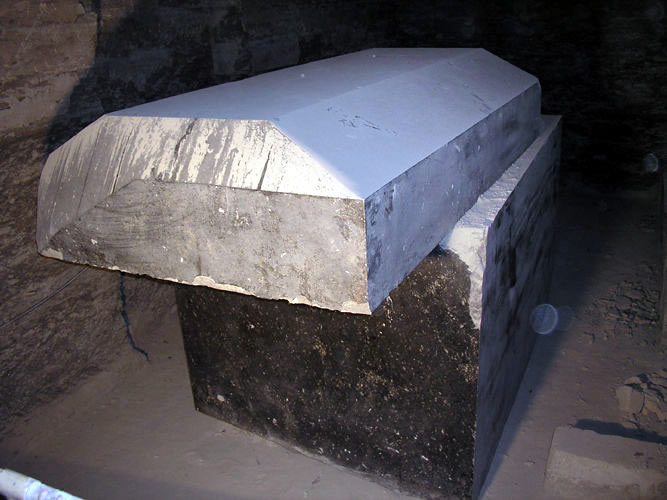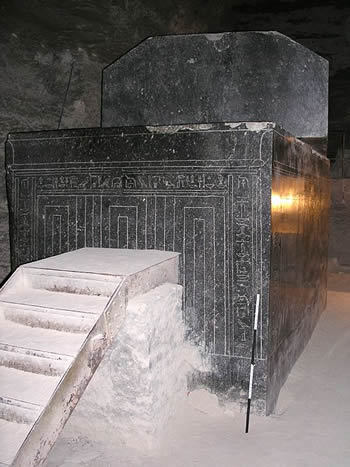Nestled in the vast expanse of the Saqqara necropolis, northwest of the iconic Pyramid of Djoser, lies a site that has captivated the imagination of historians, archaeologists, and curious minds alike – the Serapeum of Saqqara. This ancient Egyptian burial complex, dating back to around 1300 BC during the reign of Ramesses II, has long puzzled researchers with its sheer scale, intricate construction, and the enigmatic nature of its purpose.
The Serapeum of Saqqara is renowned for its impressive array of massive stone sarcophagi, each weighing between 70 to 100 tons. These colossal structures, made of rose granite or even harder diorite, were sourced from quarries hundreds of kilometers away, showcasing the ancient Egyptians’ remarkable engineering prowess and their mastery of complex geometric and mathematical principles.
However, the true purpose of these sarcophagi has remained a mystery, as many were found to be empty, leaving researchers to ponder their true function and the rituals or beliefs that may have surrounded them. The precision of these structures, with deviations of only thousandths of an inch, further adds to the intrigue, leading to inquiries about the techniques and tools used in their creation.
In this blog post, we will delve into the fascinating history and ongoing investigations surrounding the Serapeum of Saqqara, exploring the theories and insights that have emerged over the years. From the site’s significance in ancient Egyptian religious and funerary practices to the technological marvels that were employed in its construction, we will unravel the enigmas that have captivated scholars and intrigued the public for generations.
The Significance of the Serapeum
The Serapeum of Saqqara was a sacred burial site dedicated to the Apis bulls, which were considered living manifestations of the god Ptah, one of the most important deities in the ancient Egyptian pantheon. These revered animals were believed to possess divine powers and were revered during their lifetimes, with elaborate funerary rituals performed upon their deaths.

The Serapeum served as the final resting place for these sacred Apis bulls, with each individual bull being interred in one of the massive stone sarcophagi that dot the site. The sheer scale and grandeur of these structures suggest that the Apis bulls were held in the highest regard, and their burials were imbued with profound religious significance.
Interestingly, while the sarcophagi were designed to house the remains of the Apis bulls, many of them were found to be empty upon their discovery in the 19th century. This has led to ongoing speculation about the true purpose and function of these enigmatic structures, with some scholars suggesting that they may have served as symbolic or cenotaphic tombs, rather than actual burial chambers.
The Architectural Marvels of the Serapeum
The Serapeum of Saqqara is a testament to the remarkable engineering and construction capabilities of the ancient Egyptians. The sheer size and precision of the sarcophagi are truly astounding, showcasing the advanced knowledge and skill of the builders.
Each of the 25 sarcophagi is made of a single block of stone, weighing between 70 to 100 tons. The materials used, such as rose granite and diorite, were sourced from quarries hundreds of kilometers away, requiring an intricate system of transportation and logistics to move these massive blocks to the site.

The level of precision in the construction of the sarcophagi is truly remarkable. The deviations in their dimensions are measured in only thousandths of an inch, indicating a level of craftsmanship that is almost unimaginable for the time period. This precision suggests the use of advanced geometric and mathematical principles, as well as the employment of highly skilled artisans and engineers.
The question of how these massive structures were moved and positioned within the Serapeum has been a subject of ongoing debate. Some scholars have proposed the use of complex pulley systems, levers, and even the involvement of large labor forces to maneuver the sarcophagi into their final resting places. Others have speculated about the possibility of more advanced technologies, such as the use of counterweights or even primitive forms of machinery, being employed in the construction process.
Theories and Hypotheses
The Serapeum of Saqqara has been the subject of numerous theories and hypotheses over the years, as scholars and researchers have sought to unravel the mysteries surrounding this enigmatic site.
One of the most widely discussed theories is the possibility that the sarcophagi were not intended to house the remains of Apis bulls at all, but rather served a different, as-yet-undetermined purpose. Some researchers have suggested that the sarcophagi may have been used for the storage of valuable artifacts, sacred relics, or even the remains of important historical figures, rather than the Apis bulls.

Another theory proposes that the Serapeum may have been a site of initiation or ritual significance, where ancient Egyptian priests or initiates underwent transformative experiences or spiritual practices. The empty sarcophagi could have been used as part of these rituals, perhaps serving as symbolic or metaphorical “tombs” for the participants.
Some researchers have also speculated about the possibility of extraterrestrial influence or the involvement of advanced ancient civilizations in the construction of the Serapeum. These theories often suggest the use of advanced technologies, such as anti-gravity devices or highly sophisticated engineering techniques, that would have been beyond the capabilities of the ancient Egyptians.
While these theories remain speculative and unproven, they have captured the imagination of the public and continue to fuel ongoing discussions and investigations into the mysteries of the Serapeum.
The Ongoing Investigations
The Serapeum of Saqqara continues to be a subject of intense study and investigation by archaeologists, historians, and researchers from around the world. As new technologies and analytical methods emerge, the potential for unlocking the secrets of this ancient site grows ever more tantalizing.
In recent years, advanced imaging techniques, such as ground-penetrating radar and 3D scanning, have been employed to explore the Serapeum in greater detail. These technologies have provided new insights into the site’s layout, the construction of the sarcophagi, and the potential existence of any undiscovered chambers or artifacts.

Additionally, ongoing excavations and research have yielded valuable information about the rituals and practices associated with the Apis bulls, shedding light on the religious and cultural significance of the Serapeum. Researchers have also continued to study the materials and construction methods used in the sarcophagi, seeking to understand the technological capabilities of the ancient Egyptians.
As the investigation into the Serapeum of Saqqara continues, it is likely that new discoveries and revelations will emerge, further expanding our understanding of this enigmatic site and its place in the rich tapestry of ancient Egyptian history. The mysteries of the Serapeum may never be fully solved, but the pursuit of these answers remains a captivating and important endeavor for scholars and enthusiasts alike.
Conclusion
The Serapeum of Saqqara stands as a testament to the remarkable achievements of the ancient Egyptians, showcasing their mastery of engineering, mathematics, and religious practices. This enigmatic site has captivated the imagination of researchers and the public for generations, and the ongoing investigations into its secrets continue to yield fascinating insights and new avenues of inquiry.
From the colossal sarcophagi to the unanswered questions surrounding their purpose and construction, the Serapeum of Saqqara remains a enigmatic and intriguing chapter in the rich history of ancient Egypt. As we continue to unravel the mysteries of this remarkable site, we gain a deeper understanding of the ingenuity, beliefs, and cultural sophistication of a civilization that has left an indelible mark on the world.
Whether the true purpose of the Serapeum is ever fully revealed or remains shrouded in mystery, its enduring legacy as a testament to the remarkable capabilities of the ancient Egyptians is assured. As we explore and study this captivating site, we are reminded of the boundless human potential for innovation, creativity, and the pursuit of knowledge, even in the face of the most daunting challenges.
